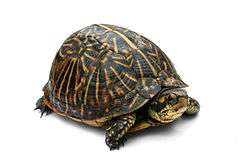Meiolaniidae
| Meiolaniidae Temporal range: Eocene to Holocene 48–recent Ma | |
|---|---|
 | |
| Ninjemys oweni and Meiolania platyceps | |
| Scientific classification | |
| Kingdom: | Animalia |
| Phylum: | Chordata |
| Class: | Reptilia |
| Clade: | Pantestudines |
| Family: | †Meiolaniidae Lydekker, 1887 |
| Genera | |
| |
Meiolaniidae is an extinct family of large, possibly herbivorous turtles with heavily armored heads and tails. They are best known from the last surviving genus, Meiolania, which lived in the rain forests of Australia from the Oligocene until the Pleistocene, and relict populations that lived on Lord Howe Island and New Caledonia until 2000 years ago. A similar form is also known from the Miocene Saint Bathans Fauna of New Zealand.[2]
The family was once thought to have originated in Australia sometime in the Oligocene, when the earliest Meiolania first appeared. However, due to the discovery of South American meiolaniids, including Crossochelys and Niolamia in Eocene Argentina, it is now believed that the meiolaniids appeared sometime prior to the breakup of Gondwana during the Cretaceous. Though once believed to be cryptodires, meiolaniids are outside of the Testudines crown-group, potentially indicating that their origin is even further back.[3][4][5] Several basal non-testudine turtles possibly related to meionaliids are known in both laurasian and gondwanann landmasses in the Cretaceous, such as the Asian Mongolochelys.[6]
references
- ↑ Juliana Sterli; Marcelo S. de la Fuente; J. Marcelo Krause (2015). "A new turtle from the Palaeogene of Patagonia (Argentina) sheds new light on the diversity and evolution of the bizarre clade of horned turtles (Meiolaniidae, Testudinata)". Zoological Journal of the Linnean Society 174 (3): 519–548. doi:10.1111/zoj.12252.
- ↑ Trevor H. Worthy, Terrestrial Turtle Fossils from New Zealand Refloat Moa's Ark, Article in Copeia 2011(1):72-76 · March 2011 Impact Factor: 1.03 · DOI: 10.2307/41261852
- ↑ Anquetin, J. R. M. (2012). "Reassessment of the phylogenetic interrelationships of basal turtles (Testudinata)". Journal of Systematic Palaeontology 10: 3. doi:10.1080/14772019.2011.558928.
- ↑ Sterli, J. (2010). "Phylogenetic relationships among extinct and extant turtles: the position of Pleurodira and the effects of the fossils on rooting crown-group turtles". Contributions to Zoology 79 (3): 93–106.
- ↑ New evidence from the Palaeocene of Patagonia (Argentina) on the evolution and palaeo-biogeography of Meiolaniformes (Testudinata, new taxon name), Journal of Systematic Palaeontology Volume 11, Issue 7, 2013, DOI:10.1080/14772019.2012.708674
- ↑ J. Sterli and M. S. de la Fuente. 2013. New evidence from the Palaeocene of Patagonia (Argentina) on the evolution and palaeo-biogeography of Meiolaniformes (Testudinata, new taxon name). Journal of Systematic Palaeontology 11(7):835-852
See also
-
 Turtles portal
Turtles portal